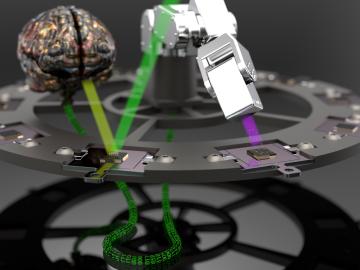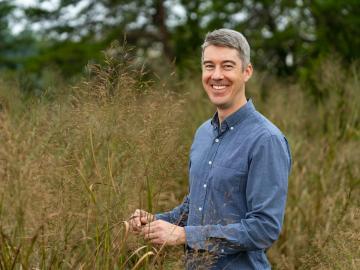Filter News
Area of Research
- Advanced Manufacturing (29)
- Biological Systems (16)
- Biology and Environment (116)
- Biology and Soft Matter (1)
- Building Technologies (10)
- Chemical and Engineering Materials (1)
- Chemistry and Physics at Interfaces (5)
- Clean Energy (397)
- Climate and Environmental Systems (6)
- Computational Biology (5)
- Computational Engineering (4)
- Computer Science (14)
- Data (1)
- Electricity and Smart Grid (1)
- Energy Frontier Research Centers (8)
- Energy Sciences (4)
- Fossil Energy (3)
- Fuel Cycle Science and Technology (1)
- Functional Materials for Energy (7)
- Fusion and Fission (28)
- Fusion Energy (10)
- Geographic Information Science and Technology (2)
- Isotope Development and Production (3)
- Isotopes (22)
- Materials (313)
- Materials Characterization (2)
- Materials for Computing (23)
- Materials Synthesis from Atoms to Systems (6)
- Materials Under Extremes (6)
- Mathematics (1)
- National Security (48)
- Neutron Data Analysis and Visualization (2)
- Neutron Science (120)
- Nuclear Science and Technology (47)
- Nuclear Systems Modeling, Simulation and Validation (3)
- Nuclear Systems Technology (1)
- Quantum Condensed Matter (1)
- Quantum information Science (4)
- Reactor Technology (1)
- Renewable Energy (3)
- Sensors and Controls (4)
- Supercomputing (157)
- Transportation Systems (7)
News Type
Date
News Topics
- 3-D Printing/Advanced Manufacturing (87)
- Advanced Reactors (25)
- Artificial Intelligence (46)
- Big Data (30)
- Bioenergy (56)
- Biology (60)
- Biomedical (36)
- Biotechnology (14)
- Buildings (41)
- Chemical Sciences (47)
- Clean Water (20)
- Climate Change (59)
- Composites (20)
- Computer Science (109)
- Coronavirus (34)
- Critical Materials (24)
- Cybersecurity (26)
- Decarbonization (42)
- Education (3)
- Element Discovery (1)
- Energy Storage (86)
- Environment (116)
- Exascale Computing (13)
- Fossil Energy (1)
- Frontier (18)
- Fusion (30)
- Grid (42)
- High-Performance Computing (46)
- Hydropower (8)
- Irradiation (2)
- Isotopes (32)
- ITER (6)
- Machine Learning (28)
- Materials (101)
- Materials Science (95)
- Mathematics (5)
- Mercury (9)
- Microscopy (36)
- Molten Salt (7)
- Nanotechnology (44)
- National Security (36)
- Net Zero (6)
- Neutron Science (84)
- Nuclear Energy (58)
- Partnerships (28)
- Physics (44)
- Polymers (26)
- Quantum Computing (14)
- Quantum Science (38)
- Renewable Energy (1)
- Security (18)
- Simulation (19)
- Space Exploration (13)
- Statistics (3)
- Summit (28)
- Sustainable Energy (88)
- Transformational Challenge Reactor (4)
- Transportation (72)
Media Contacts

Farragut High School graduate Channing Tan has been named recipient of the 2024 UT-Battelle Scholarship to attend the University of Tennessee.

Researchers at ORNL have successfully demonstrated the first 270-kW wireless power transfer to a light-duty electric vehicle. The demonstration used a Porsche Taycan and was conducted in collaboration with Volkswagen Group of America using the ORNL-developed polyphase wireless charging system.

Sara Martinez ensures the safety and longevity of aging structures at Oak Ridge National Laboratory, employing her engineering expertise to protect against natural disasters and extend the lifespan of critical facilities.

An Oak Ridge National Laboratory team revealed how chemical species form in a highly reactive molten salt mixture of aluminum chloride and potassium chloride by unraveling vibrational signatures and observing ion exchanges.

Six firms received Small Business Awards from the Department of Energy’s Oak Ridge National Laboratory. The companies, selected from small business service providers to the lab, were recognized by ORNL's Small Business Programs Office for their specific capabilities and contributions.

Researchers at Oak Ridge National Laboratory have developed free data sets to estimate how much energy any building in the contiguous U.S. will use in 2100. These data sets provide planners a way to anticipate future energy needs as the climate changes.

Today, scientific discovery is accelerated by automated experiments, artificial intelligence and high-performance computing. A novel tool developed at ORNL that leverages those technologies has demonstrated that AI can influence materials synthesis and conduct associated experiments without human supervision.

The United States has enough biomass potential to produce 35 billion gallons per year of aviation biofuel by 2050, a new report confirms. ORNL’s John Field provided biomass feedstock production expertise to the report focused on the role of the bioeconomy in U.S. decarbonization strategies.

Oak Ridge National Laboratory scientists ingeniously created a sustainable, soft material by combining rubber with woody reinforcements and incorporating “smart” linkages between the components that unlock on demand.

Early career scientist Frankie White's was part of two major isotope projects at the same time he was preparing to be a father. As co-lead on a team that achieved the first synthesis and characterization of a radium compound using single crystal X-ray diffraction and part of a team that characterized the properties of promethium, White reflects on the life-changing timeline at work, and at home.




